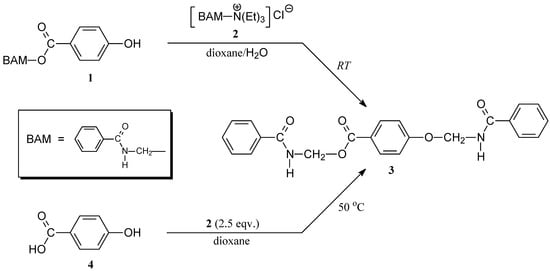Abstract
In this note, two procedures for the synthesis of (benzoylamino)methyl 4-[(benzoylamino)methoxy]benzoate (3) are presented. The first procedure is carried out in dioxane/water using benzoylaminomethyl-4-hydroxybenzoate, while the second one employs a suspension of 4-hydroxybenzoic acid in dioxane. In both procedures, benzamidomethyl triethylammonium chloride is used for the benzamidomethylation reaction.
Methyl 4-methoxybenzoate (also known as methyl anisate) is a white crystalline powder, soluble in alcohol and ether, but insoluble in water. In the nature, it occurs as a volatile compound in mushroom species and plants [,,,,]. These types of esters are used as pharmaceutical intermediates and take part in many organic syntheses [,]. For example, a new imaging compound, [(125)I]iodoDPA-713, was synthesized in several steps from methyl 4-methoxybenzoate as a tool for quantification of inflammation in preclinical models []. Nowadays, methyl 4-methoxybenzoate has application in the flavor and perfume industry as synthetic flavoring substance due to its sweet herbal anis aroma, impressing lilac or magnolia [,].
In this note, the synthesis of a new compound, (benzoylamino)methyl 4-[(benzoylamino)methoxy]benzoate (3), similar to methyl anisate, is reported. The synthesis of 3 was carried out by using (benzamidomethyl)triethylammonium chloride (2) as a reagent for benzamidomethylation. Although 2 is an excellent reagent for benzamidomethylation of phenols [], in our previous work [] we demonstrated that the phenol group at 4-hydroxybenzoic acid (4) cannot be benzamidomethylated with 2 in aqueous media. The carboxylic group as a weak nucleophile in aqueous media does not react [], but it deactivates the phenol group in the molecule of 4-hydroxybenzoic acid. However, once the carboxylic group is protected as in (benzoylamino)methyl 4-hydroxybenzoate (1), the hydroxyl group can be easily benzamidomethylated with 2 in aqueous media to obtain 3 (Scheme 1).

Scheme 1.
Synthetic routes to the title compound 3.
As presented in Scheme 1, the title compound can also be obtained directly from 4 in dioxane suspension of 2 at 50 °C.
Experimental
Compound 2 is not commercially available and it was synthesized as described previously [].
(Benzoylamino)methyl 4-[(benzoylamino)methoxy]benzoate (3)
Procedure A
To a mixture of 1 (0.310 g, 1.14 mmol), well powdered 2 (0.334 g, 1.23 mmol), dioxane (25 mL) and triethylamine (0.1 mL) was added water drop by drop, until a clear solution was obtained. The mixture was stirred for 10 h at room temperature and subsequently water was added until occurrence of a precipitate. The maximal yield of crude colorless crystals was 70%. The purification was performed firstly by dissolving the product in dioxane and by precipitation with water and then by recrystallization from ethyl acetate.
Procedure B
To a suspension of 2 (0.529 g, 1.95 mmol) in dioxane (10 mL) were added 4 (0.108 g, 0.78 mmol) and TEA (0.1 mL). The mixture was stirred and heated at 50 °C for 24 h. After cooling, water was added until a white precipitate occurred. The colorless crystals were filtered off and purified as described in Procedure A. Maximum yield was 56%.
Melting point of pure crystals: 176.5–177.5 °C (uncorrected).
FT-IR (KBr): 3,311 (νNH), 1,728 (νOC=O), 1,655 (Amide I), 1,536 cm−1 (Amide II).
1H-NMR (250 MHz, DMSO-d6): δ/ppm 9.62 (t, J = 6.7 Hz, 2H, 2xNH); 7.95–7.15 (14H, Ar); 5.57 (d, J = 6.7 Hz, 2H, N-CH2-O); 5.40 (d, J = 6.7 Hz, 2H, N-CH2-O)
13C-NMR (63 MHz, DMSO-d6): δ/ppm 167.1 (C=O); 167.0 (C=O); 68.7 (CH2); 65.5 (CH2); Ar: 161.0, 133.3, 133.2, 132.1, 131.4, 128.5, 127.6, 127.5, 122.2, 115.3.
Anal. Calcd. (found) for C23H20N2O5: C, 68.31 (68.13); H, 4.98 (5.19); N, 6.93 (6.85).
Supplementary materials
Supplementary File 1Supplementary File 2Supplementary File 3References
- Rapior, S.; Breheret, S.; Talou, T.; Pélissier, Y.; Bessière, J.-M. The anise-like odor of Clitocybe odora, Lentinellus cochleatus and Agaricus essettei. Mycologia 2002, 94, 373–376. [Google Scholar] [CrossRef] [PubMed]
- Binder, R.G.; Flath, R.A. Volatile components of pineapple guava. J. Agric. Food Chem. 1989, 37, 734–736. [Google Scholar] [CrossRef]
- Hardy, P.J.; Michael, B.J. Volatile components of feijoa fruits. Phytochemistry 1970, 9, 1355–1357. [Google Scholar] [CrossRef]
- Shaw, G.J.; Ellingham, P.J.; Birch, E.J. Volatile constituents of feijoa-headspace analysis of intact fruit. J. Sci. Food Agr. 1983, 34, 743–747. [Google Scholar] [CrossRef]
- Ceballos, L.; Pino, J.A.; Quijano-Celis, C.E.; Dago, A. Optimization of a HS-SPME/GC-MS Method for determination of volatile compounds in some Cuban unifloral honeys. J. Food Quality 2010, 33, 507–528. [Google Scholar] [CrossRef]
- Wang, H.; Pullambhatla, M.; Guilarte, T.R.; Mease, R.C.; Pomper, M.G. Synthesis of [125I]iodoDPA-713: A new probe for imaging inflammation. Biochem. Biophys. Res. Commun. 2009, 389, 80–83. [Google Scholar] [CrossRef] [PubMed]
- Chandra, B.K.; Ramadasu, G.; Gangaiah, L.; Madhusudhan, G.; Mukkanti, K. A new route for the synthesis of (R)-glyceraldehyde acetonide: A key chiral building block. Indian J. Chem. B 2010, 49, 260–263. [Google Scholar]
- Perriot, R.; Breme, K.; Meierhenrich, U.J.; Carenini, E.; Ferrando, G.; Baldovini, N. Chemical composition of French mimosa absolute oil. J. Agric. Food Chem. 2010, 58, 1844–1849. [Google Scholar] [CrossRef] [PubMed]
- Panda, H. Perfumes and flavours technology handbook; Asia Pacific Business Press Inc: Delhi, India, 2010. [Google Scholar]
- Popovski, E.; Klisarova, L.; Vikic-Topic, D. Simple method for benzamidomethylation of phenols in water solution. Synth. Commun. 1999, 29, 3451–3458. [Google Scholar] [CrossRef]
- Popovski, E.; Mladenovska, K. (Benzoylamino)methyl 4-hydroxybenzoate. Molbank 2010, 2010, M658. [Google Scholar] [CrossRef]
- Popovski, E.; Klisarova, L.; Vikic-Topic, D. Benzamidomethylation with (benzamidomethyl)triethylammonium chloride 2. A simple method for benzamidomethylation of thiols, amines and carboxylic acids. Molecules 2000, 5, 927–936. [Google Scholar] [CrossRef]
© 2010 by the authors; licensee MDPI, Basel, Switzerland. This article is an open access article distributed under the terms and conditions of the Creative Commons Attribution license (http://creativecommons.org/licenses/by/3.0/).